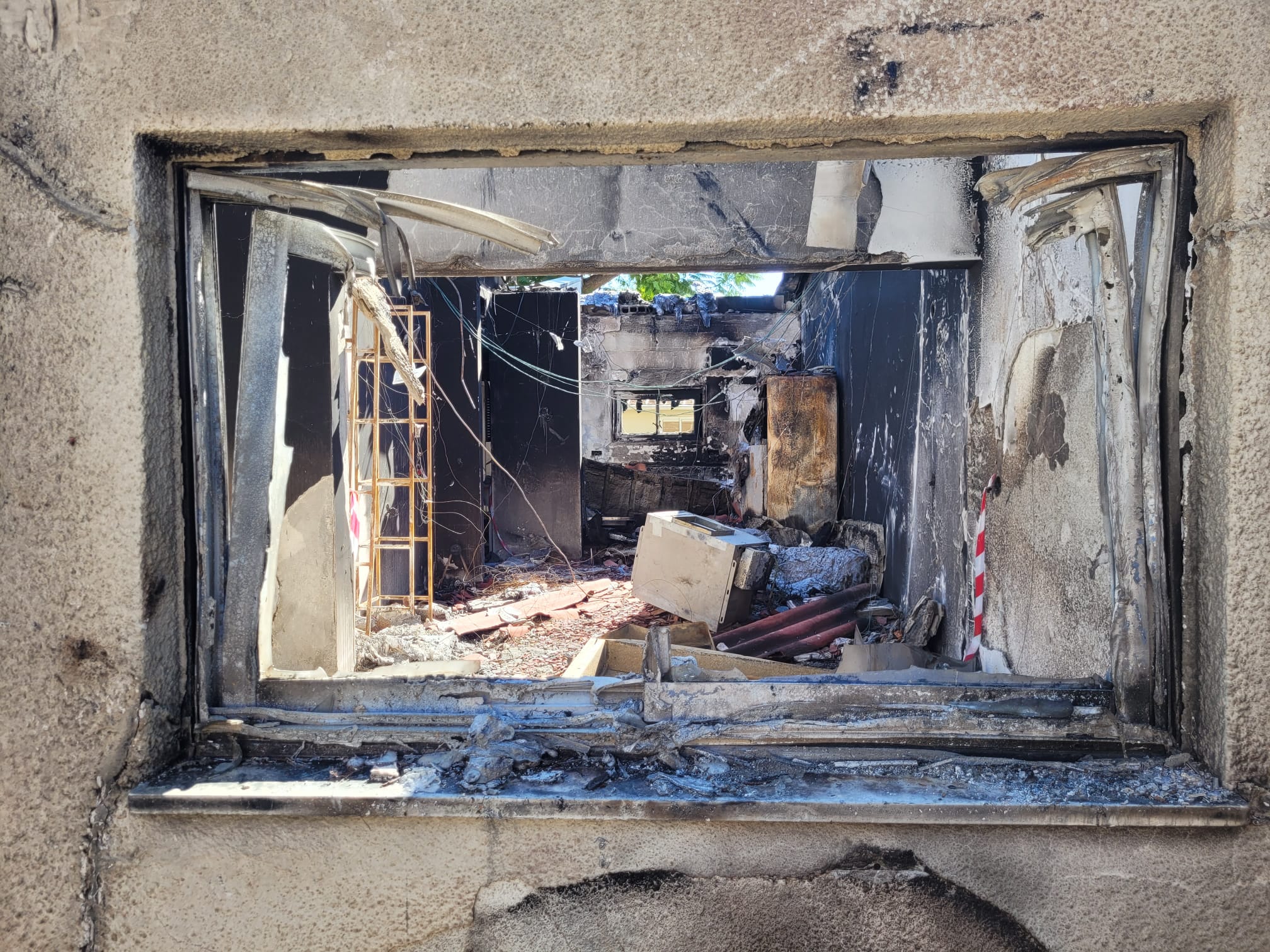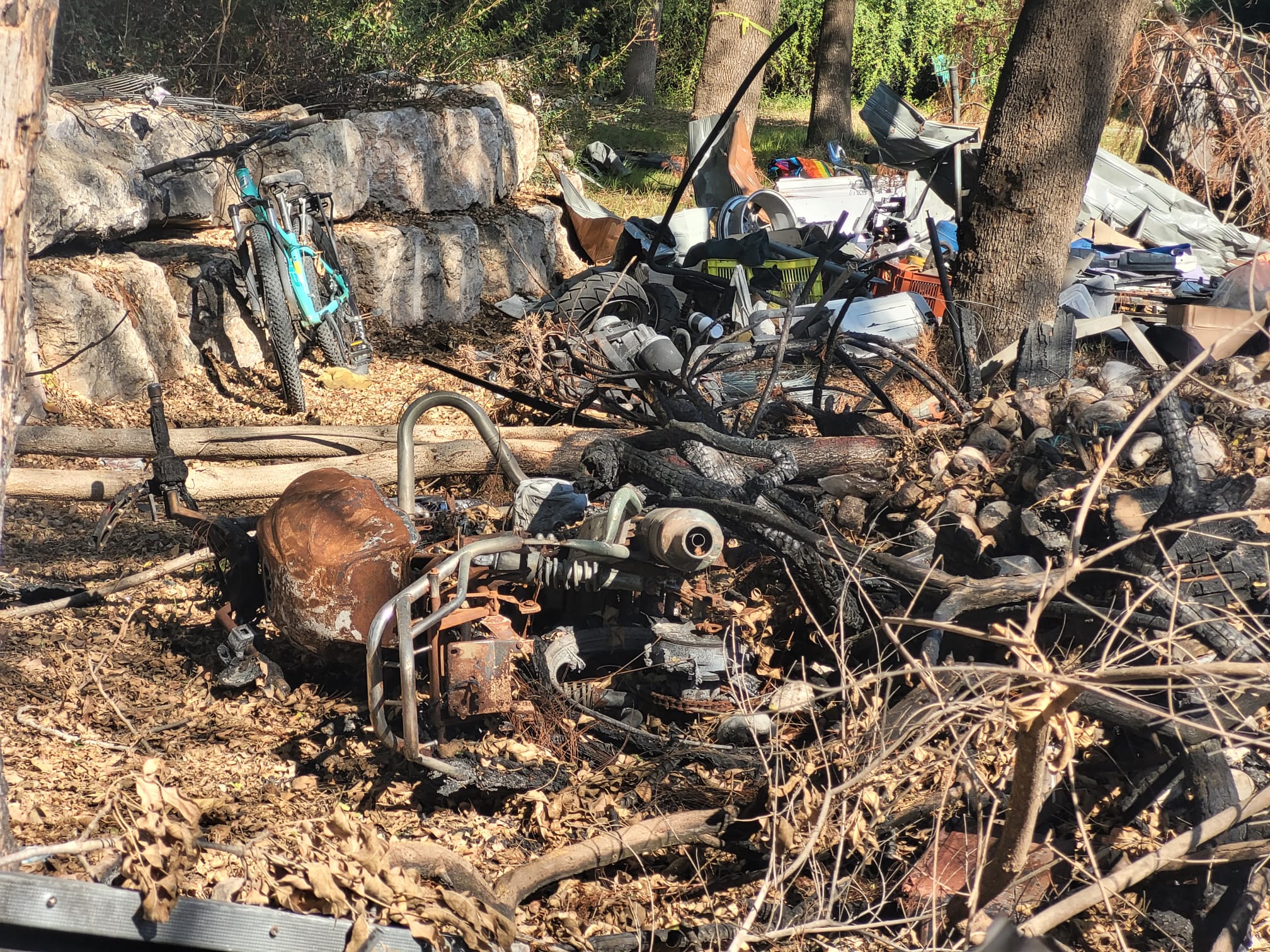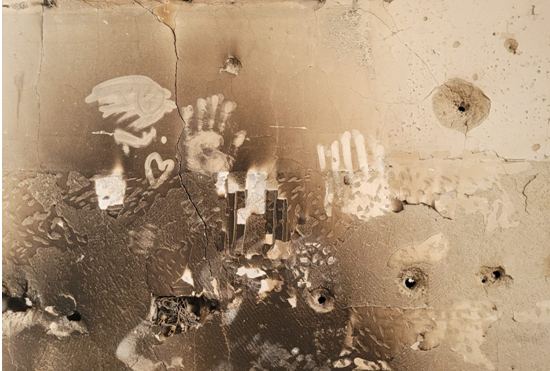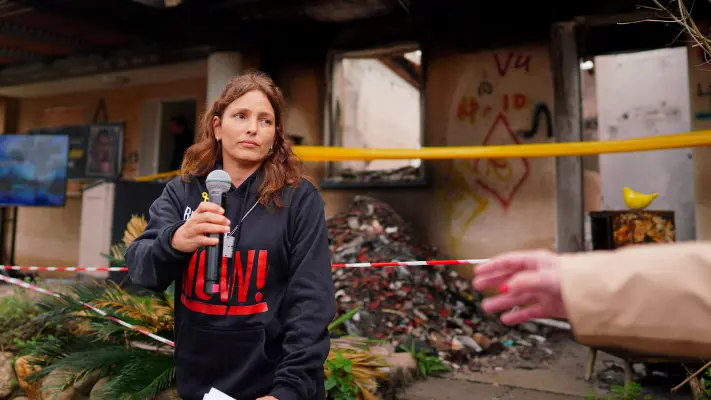Writer: Liron Lavie
Tranlsation: Nancy Zeitlin
“We’ve never seen anything like this. Do you see where that fly is? That’s human tissue, maybe the little girl’s, maybe someone else’s who was killed”. This is the beginning of our first encounter with the events of October 7th at Kibbutz Beeri. The speaker is a ZAKA volunteer who saw us arriving. {ZAKA, Disaster Victim Identification, is Israel’s dominant non–governmental rescue and recovery organization). Seems like he was looking for someone to talk to about the horrors he saw, someone to share the stories of the awful sights he witnessed, someone to help him process the terrible things he was exposed to. A little girl’s tissue…may G-d have mercy.
Last Thursday we went to Kibbutz Beeri. We went for a reason, at that moment, the day after the last house in the kibbutz was ‘cleared’. On the one hand we needed to touch, to see with our own eyes, to be exposed to things as they were without filters and to bring the story to you in order to fully capture what happened on October 7th, and on the other hand our desire for self protection from the atrocities and the hope to be able to sleep at night between all the stories, film clips and broadcasted news items.
In a moment the dissonance we’ve experienced since October 7th was realized in it’s disturbing physicality-the serene pastoral kibbutz setting merged with the devastation and destruction silently screaming out. The kibbutz entrance looks like an army base. Rows of military tanks and jeeps, dozens of men and women soldiers. As we walk along the green, blossoming kibbutz paths, artillery shells shake the ground every ten minutes, shaking us to the core every time. We’re still not accustomed to it. Birds dramatically fly out of the tall trees. The body cannot contain the gap between all this beauty and the horror that’s now part of it.

Some of the kibbutz homes have barely been damaged-the only evidence of the terrible story that unfolded here are the army and ZAKA clearance markings on the houses. Others have been partially broken: a collapsed roof, a fallen wall, a sooty floor. Many homes have been burned to the ground. Their walls screaming out their stories, and the ubiquitous ZAKA volunteers absorbing them into their beings and putting them into words, then releasing them and breathing the stories to the world.
“They went berserk here” continues our ZAKA companion about this house, “forty plus terrorists on this pathway alone”. He walks on with us, without even being asked to, as if guiding us on the pathways of atrocities. “Over there where the stairs are, that’s where we found the whole neighborhood’s passports. The terrorists collected them. Everything’s in the bag, organized, they came much better prepared than us”.
“Here in this house”, he points to a home that looks orphaned, without rooms, the Safe Room being the only part of the house left standing, “they were murdered with kitchen knives, husband and wife”.

TRIGGER WARNING
“You can enter all the homes” he soothes us, observing our alarm from the horrors he’s showing us. “Everything has been cleared, even where they murdered and there was a lot of blood”. The ZAKA personnel have almost completed their mission, 42 days after.
“How to you stay sane?” we ask. “ Impossible”, he replies, himself not able to describe what will be with him on the day after, when he doesn’t have to be here, digging through the inferno, breathing the odor of fires, separating human tissue from ashes, glass fragments and remains of homes.

Descriptions upon descriptions of situations the ZAKA personnel experienced, as if these have frozen in time. Painful descriptions and trigger warning ahead.
“We took out of here 180 bodies of terrorists” he tells us. “First we took out bodies of Israelis – from here, and from Kfar Aza {a neighboring kibbutz}. Saad had hardly anything. Nahal Oz, and at the army base, they left a mess…not one woman soldier was left complete. After they killed them, they cut them to pieces. They’re insane. I entered a home in Kfar Aza, the dog was protecting his owners. They shot the dog while he was hugging his owners, you can see the embrace…so you can’t call them “dogs” because they’re not, they’re carrions, carrions whose stench and shit we’ll carry with us our whole lives”.
He tells us that ZAKA personnel started their work on Sunday, October 8th, while terrorists were still at large on the kibbutz grounds. IDF forces gave them cover while they began their mission of collecting the bodies. “Each and every terrorist had drugs in his pockets” he tells us, “they were all on pills. One of the policemen doing identification said that that’s what ISIS used”.

?What else was on the terrorists bodies
“Drugs, weapons, candy…and papers with orderly and explicit instructions – which area each one should enter and which house, who goes where, and who takes over command if their commander is killed, and where to go to from there, they were better organized than our commando”.
“Look”. He shows us a photo of a motorcycle. “This motorcycle was found next to the infirmary. The license plate says North Sinai. This is not a Gazan motorcycle, this is from northern Sinai, from north Sinai ISIS”.

Blood Soaked Pacifier
“At Kfar Aza I found a 19 year old girl who was murdered in her bedroom. Her mother and grandmother were murdered. She was naked, on her bed in the room. She was cut. Four dead terrorists near her, one of them with his trousers rolled down. An 8 month old baby girl on the other side”.
“Here we found a lot of ammunition. Now it’s all been cleared” he continues and points at a different area of the house, “a burnt 14 year old girl, her body over there and her head here”. He needs to tell us about more and more of the horrors that he witnessed. “I entered a home in Kfar Aza, three men had their heads cut off. We looked around and couldn’t find the bodies, just the heads. Next to the fence we found three bodies and ten heads. They slaughtered them and returned to Gaza just with the head. A person can’t carry many bodies, but he can pick up five heads”.

These actions are unimaginable, even the most deranged scriptwriter wouldn’t dare write them. These horrors, these indigestible sights are borne by ZAKA personnel. And what is being borne by the Beeri survivors who witnessed it all?
“This is the room of a 7 month old baby girl”, he leads us to another home. “I found the teeth of a child who was missing. It took time, after we came back here to clean up, after we removed the bodies…insane. A child’s leg, look at the blood…” He shows us photos that he took at the first moments, when he arrived here. “Look at the blood” he repeats and shows us splashes of blood on the wall over the baby’s crib. “The mother here was wounded, she was rescued. I found the baby girl underneath…I couldn’t pick her up. I’m 47, have no children myself, and there I broke down”. And now his voice breaks again.
“Do you see the girl’s pacifier?” He shows me a photo of a clean pacifier placed on the bed in the room in which we’re standing. “It wasn’t clean like this. It was covered in blood. But I couldn’t. I sat down and cleaned the pacifier…I cleaned it and cleaned it and cleaned it…”. In your mind you imagine the situation. A robust, bearded 47 year old man broken over a blood soaked pacifier. The pacifier of a baby brutally murdered in her crib.

Hostages
“We don’t really know what cruelty is, even if you go see a bad movie, it’s nothing. I entered a home, birthday cake, grandfather, grandmother, the father, the boy is six years old…his head severed and placed next to him, a three year old girl and the mother on the floor”.
We entered the home of Liel and Yannai Hetzroni z”l {May Their Memory Be A Blessing}, 12 year old Liel’s remains identified just the previous day, Liel the twin sister of murdered Yannai. That day a farewell ceremony had been held for Liel Hetzroni, without a burial, as her body hadn’t been found. The tissues that the ZAKA man pointed at initially were the tissues that assisted in her positive identification, definitive identification that she had been murdered.

On October 7th Liel and her Aunt Ayala were taken to a different house in Beeri where 15 hostages were being held by Hamas. They were held there for hours and then murdered. Only two Israelis survived this situation, as was witnessed by Yasmin Porat, one of the survivors.
Ayala had raised Liel and Yannai, whose mother had suffered brain damage at their birth as a result of medical negligence. We identified their home by the children’s height measuring marks on the doorframe, a common practice in homes with young children. On the walls, adjacent to the innocent measuring marks, was the Hamas terrorist’s Arabic graffiti.
It was, It happened
Breathing is difficult. Notwithstanding everything we had heard, everything we had seen, we still couldn’t grasp what these children had been through for hours upon hours. The events of Kibbutz Beeri that we had heard so much about, still didn’t come together as a coherent picture, as a flow of a story that the human soul and psyche can contain.
The children’s stories, the families and grandparents stories are one with the kibbutz’s agricultural workers, no one was spared by the terrorists. “The Thai’s were slashed with knives, one girl, from here to here she was cut. At another farm, they tied together two Bedouins, a husband and wife, and shot them”.
He’s silent for a moment. As if wondering if he should continue speaking, or not. Suddenly he looks at us with a clear decision. “A 16 year old Bedouin girl…” he says and points at his own body, taking his finger from stomach to chest. “They cut her open, took out her heart. Took a piece of paper and wrote ‘Infidel’ on it. A Bedouin girl. Just imagine how much time they had”.

The people of Beeri waited hours for military assistance and salvation. Simply said, the terrorists had ample time. A long long time to destroy not only the kibbutz’s homes, but also their souls and psyches. “This is something that will take a very long time time to process” summarizes the ZAKA man. “People who live here know each other. You’re used to come over, to meet the elderly lady at dinner, to see that boy…”. He tries to envision the future to come.
We’ve chosen to bring forwards these severe stories and the descriptions of the atrocities especially because of the silencing and denial that is gaining momentum worldwide. There is a sense as if the further away we get from October 7th, the mechanisms of denial and repression are working extra hours and any evidence of the brutality of the attack, rape, slaughter and beheadings is pushed aside as many prefer to look the other way and say “It wasn’t, it didn’t happen”.

So here it is. It was, it happened, and G-d save us from those who are capable of these actions. Over the past few weeks, in conversations and interviews that we’ve conducted with the people that were there, that experienced it, whose families were kidnapped, who witnessed the events, we see the magnitude of what a terrorist organization, calling itself a “Occupation Resistance Organization”, is capable of doing. We know what it’s aspirations were and what motivated it.
The walls of the Beeri houses do not have calls for the liberation of Palestine written on them. They have the names of the terror organizations that came there, occupied, murdered and slaughtered. “We were here, Izz ad-Din al-Qassam Brigades”. Conquering a girl’s body, murdering a baby in her crib. Just like raging and bloodthirsty pirates, they returned home with severed heads. In the name of what resistance was this horror carried out? And in what world can resistance to occupation be justified by a baby murdered in his crib, or a child who’s been raped?







